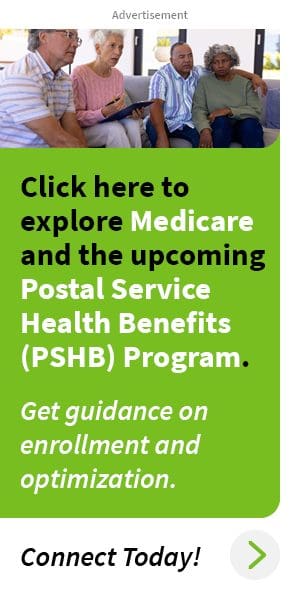Key Takeaways
-
If you are eligible for Medicare and skip enrolling in Part D, your prescription drug coverage under your PSHB plan may be significantly limited or terminated altogether.
-
The PSHB program in 2025 integrates Medicare Part D through a specific prescription drug arrangement, and opting out of Part D can trigger major coverage gaps.
Understanding the 2025 Prescription Drug Structure Under PSHB
In 2025, the Postal Service Health Benefits (PSHB) program is officially separate from the broader Federal Employees Health Benefits (FEHB) program. One of the key features of this change is the integration of Medicare Part D for eligible annuitants and their family members. If you’re Medicare-eligible and enrolled in a PSHB plan, your drug benefits are now directly tied to a Medicare Part D Employer Group Waiver Plan (EGWP).
This integration is automatic—unless you actively opt out. But what many retirees don’t realize is that opting out of Medicare Part D doesn’t mean your PSHB plan will just pick up the slack. In fact, it often means you lose access to prescription drug coverage through your PSHB plan entirely.
What Happens When You Decline Medicare Part D
Declining Part D while enrolled in a PSHB plan as a Medicare-eligible annuitant typically leads to the loss of prescription drug coverage under that plan. Here’s what that looks like:
-
Automatic enrollment is standard: If you qualify for Medicare, you are automatically enrolled in the plan’s EGWP-based Part D coverage.
-
Opting out removes drug coverage: Choosing to opt out of the integrated Part D plan results in losing access to the plan’s pharmacy benefits.
-
Reenrollment is limited: If you change your mind later, you may not be able to rejoin the Part D plan right away—and PSHB drug coverage won’t resume until you do.
This can create a serious coverage gap, especially if you take maintenance medications or anticipate costly prescriptions.
Medicare Part D Is No Longer Optional for Many PSHB Annuitants
Since 2025, Medicare-eligible Postal Service retirees must be enrolled in Medicare Part B and Part D to maintain full benefits under PSHB. While exceptions exist for a small number of retirees—such as those who retired before January 1, 2025, or are covered through other programs—most do not qualify for these exclusions.
If you skip Part D thinking your PSHB plan will still include drug benefits, that’s no longer the case for most enrollees.
Who Is Affected:
-
Retirees who turned 65 and became Medicare-eligible in 2025 or earlier
-
Annuitants with family members who are Medicare-eligible
-
Anyone automatically enrolled in the PSHB plan’s EGWP and considering opting out
You Could Lose More Than Drug Coverage
Many PSHB plans now coordinate benefits with Medicare, which helps lower your overall out-of-pocket costs. This includes reduced deductibles, lower coinsurance, and improved cost-sharing when you have both Medicare and PSHB.
If you opt out of Part D:
-
Your prescription coverage disappears
-
Cost savings tied to Medicare coordination vanish
-
You might be subject to full plan deductibles and coinsurance on your own
Additionally, opting out could mean:
-
No access to the integrated pharmacy network
-
Loss of coverage for brand-name or specialty medications
-
Higher total out-of-pocket drug spending with no cap
Understanding the New $2,000 Out-of-Pocket Cap in Part D
One of the biggest benefits in 2025 is the new $2,000 annual out-of-pocket limit for Medicare Part D. This cap provides a financial safety net for those with high medication costs.
But if you decline Medicare Part D:
-
You lose access to that $2,000 cap
-
There’s no comparable limit under your PSHB plan once drug coverage is dropped
-
Your pharmacy costs can continue to rise with no stop-loss protection
This makes declining Part D not just risky—but potentially expensive.
Monthly Payment Option for High Drug Costs
The Medicare Prescription Payment Plan also launches in 2025. It allows you to spread your out-of-pocket drug costs over the year in predictable monthly payments, instead of paying all at once when you fill a costly prescription.
If you’re enrolled in your PSHB plan’s Part D benefit, you’re automatically eligible for this monthly payment option. But if you’ve opted out of Part D, you can’t use this feature, even if your prescription costs are high.
How and When You Can Opt Back In
If you change your mind and want to rejoin Medicare Part D through your PSHB plan, there are strict rules:
-
Enrollment is only available during specific Medicare enrollment periods.
-
Outside those periods, you must qualify for a Special Enrollment Period (SEP).
-
Late enrollment penalties may apply.
You may also need to wait until the next Open Season for your PSHB plan to resume full benefits. That means you could be left without drug coverage for many months.
Exceptions to the Rule: Who Might Not Need Part D
There are limited cases where opting out of Medicare Part D won’t affect your PSHB drug coverage. These exceptions include:
-
Retirees who are not Medicare-eligible
-
Annuitants who retired before January 1, 2025 and are exempt under the law
-
Medicare-eligible individuals who have other creditable drug coverage, such as from the VA or Indian Health Services
-
Certain residents living overseas, where Medicare doesn’t apply
If you fall into one of these categories, you won’t be forced to enroll in Part D to retain PSHB drug coverage—but it’s still worth confirming your exact eligibility with a licensed agent.
The Opt-Out Process Is Easy—Too Easy
One of the pitfalls of the new system is that opting out of Part D is as simple as returning a form. But doing so has serious consequences:
-
Once you’re out, your PSHB plan drops your drug coverage
-
You can’t just change your mind mid-year unless you meet strict criteria
-
Your healthcare costs could rise substantially until your next chance to enroll
Many retirees mistake the opt-out form as a harmless option. In reality, it can cut off access to your medications almost immediately.
Be Proactive: Check Your PSHB Plan’s Drug Integration Details
Not all PSHB plans are the same. Some offer more generous coordination with Medicare. Some waive deductibles or lower copays if you’re enrolled in Part B and D. Others strictly follow Medicare’s structure.
Review your plan brochure or summary of benefits for:
-
Prescription drug benefits with and without Medicare
-
Pharmacy network access and formulary limitations
-
Whether you qualify for cost-sharing reductions
Understanding these details helps you avoid unexpected losses in coverage.
Talk to a Licensed Agent Before You Decide
The decision to stay in or opt out of Medicare Part D isn’t just about current costs—it’s about long-term access to medications, protections from catastrophic drug expenses, and full plan coordination under PSHB.
Many enrollees don’t realize what they’re giving up until it’s too late.
A licensed agent listed on this website can help you:
-
Clarify whether you’re required to stay in Part D
-
Explore what your PSHB plan includes or excludes
-
Estimate potential out-of-pocket drug costs
It’s not worth risking your coverage just to skip a form. Get guidance before you opt out.
Protect Your Access to Medication Before It’s Disrupted
As a Medicare-eligible annuitant under PSHB, staying enrolled in Medicare Part D in 2025 is no longer a side option—it’s a crucial part of keeping your drug coverage intact. Without it, your medications might not be covered at all, and you’ll face higher costs, stricter limitations, and fewer protections.
If you’re unsure whether your status requires Part D enrollment, or if you’re thinking of opting out, speak with a licensed agent listed on this website today. A brief conversation can save you from a year of uncovered prescriptions and surprise bills.










